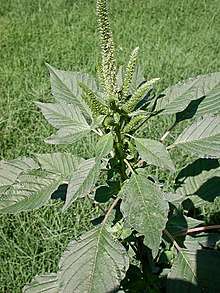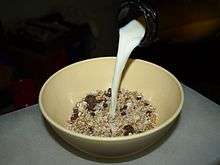Amaranthus palmeri
Amaranthus palmeri is a species of edible flowering plant in the amaranth genus. It has several common names, including carelessweed,[1] dioecious amaranth,[2] Palmer's amaranth, Palmer amaranth, and Palmer's pigweed. It is native to most of the southern half of North America. Populations in the eastern United States are probably naturalized. It has also been introduced to Europe, Australia, and other areas. The plant is fast-growing and highly competitive.
| Amaranthus palmeri | |
|---|---|
 | |
| Scientific classification | |
| Kingdom: | Plantae |
| Clade: | Tracheophytes |
| Clade: | Angiosperms |
| Clade: | Eudicots |
| Order: | Caryophyllales |
| Family: | Amaranthaceae |
| Genus: | Amaranthus |
| Species: | A. palmeri |
| Binomial name | |
| Amaranthus palmeri | |
Uses

The leaves, stems and seeds of Palmer amaranth, like those of other amaranths, are edible and highly nutritious.[1][3] Palmer amaranth was once widely cultivated and eaten by Native Americans across North America, both for its abundant seeds and as a cooked or dried green vegetable.[3] Other related Amaranthus species have been grown as crops for their greens and seeds for thousands of years in Mexico, South America, the Caribbean, Africa, India, and China.
The plant can be toxic to livestock animals due to the presence of nitrates in the leaves.[4] Palmer amaranth has a tendency to absorb excess soil nitrogen, and if grown in overly fertilized soils, it can contain excessive levels of nitrates, even for humans. Like spinach and many other leafy greens, amaranth leaves also contain oxalic acid, which can be harmful to individuals with kidney problems if consumed in excess.[5]
Because of its toxicity to livestock,[4] and scarce familiarity in the United States with the uses of amaranths as food, Palmer amaranth is rarely consumed nowadays, despite its ubiquity and resistance to drought. Unlike the grain and leaf amaranths of other regions, it has not been cultivated or further improved by recent agricultural breeding.[6] As a result, the primary economic importance of Palmer amaranth to American farmers has been as a noxious weed and a competitor to more marketable crops, rather than as a crop in its own right.[1]
As a weed
Palmer amaranth is considered a threat most specifically to the production of cotton and soybean crops in the southern United States. In many places, the plant has developed resistance since at least 2006 to glyphosate, a widely used broad-spectrum herbicide.[7][8][9] Glyphosate-resistant pigweed not only dominates in cotton fields, but also has wide-ranging effects on other crops and productions.[10] In 2001, Palmer amaranth was found in the southern quarter of Illinois and appeared to be moving to northern Illinois in 2006.[11]
In 2014, the Texas Department of Agriculture asked the United States Environmental Protection Agency for permission to use the restricted chemical herbicide propazine on 3 million acres (1.2 million hectares) of cotton threatened by Palmer amaranth.[12] The request was denied due to unacceptable risks to drinking water.[13]
In 2019, Kansas State University researchers documented a population of Palmer amaranth with resistance to 2,4-D and Dicamba in Kansas. Previously, Palmer amaranth in Kansas has developed resistance to ALS, atrazine, glyphosate and HPPD herbicides—mesotrione, Huskie, Laudis, Impact, and Armezon—leaving growers with very few postemergence options to manage this weed.[14]
Growth
Palmer amaranth may be the most aggressive pigweed species with respect to growth rate and competitive ability.[15] Palmer amaranth in particular is highly competitive. It will outgrow cotton and is much more efficient. Growers of crops have not been able to provide adequate moisture to offset prolonged temperatures above 85 °F with 112 °F heat indices. In these conditions, many herbicides break down over time and Palmer amaranth will keep thrusting. It can grow from 2 to 5 inches (51–127 mm) in three days, or less.[10] In only a few weeks, it can grow from 12 to 18 in (305–457 mm) compared to cotton at 5 to 8 in. (127–203 mm).[16]
Spread
Pollen is most commonly spread by wind.[10] The male produces the pollen and the female plant produces the seed. The wind carries the pollen from resistant male plants to female plants. In addition, the seed is spread by traditional means, such as harvesting, inadequate cleaning of equipment, and the spreading of infested materials, such as manure.[15]
In 2014, North Dakota State University's "ND Weed Control Guide" selected Amaranthus palmeri, as "weed-of-the-year" to raise awareness about its "potentially devastating impact."[17]:5 In 2015, Palmer amaranth was chosen as "weed-of-the-year" for the second year in a row as a "proactive approach to prevent Palmer amaranth establishment in North Dakota."[18]
References
- "Amaranthus palmeri". Natural Resources Conservation Service PLANTS Database. USDA. Retrieved 7 January 2016.
- "BSBI List 2007". Botanical Society of Britain and Ireland. Archived from the original (xls) on 2014-10-23. Retrieved 2014-10-17.
- "Native American Ethnobotany Database".
- "Plants Poisonous to Animals". Cornell University Department of Animal Science.
- "Low Oxalate Diet". University of Pittsburgh Medical Center.
- "Amaranthus species". Purdue University Center for New Crops and Plants Products.
- Andrew Leonard (27 August 2008). "Monsanto's bane: The evil pigweed". Salon.com.
- Clea Caulcutt (19 Apr 2009). "'Superweed' explosion threatens Monsanto heartlands". France 24.
- Culpepper AS, Grey TL, Vencill WK, Kichler JM, Webster TM, Brown SM, et al. (2006). "Glyphosate-resistant Palmer amaranth (Amaranthus palmeri) confirmed in Georgia". Weed Sci. 54 (4): 620–626. doi:10.1614/WS-06-001R.1.
- Roy Roberson (8 Aug 2006). "Herbicide resistance may change future of row crop farming in Southeast". Southeast Farm Press.
- Hager, Aaron; Sprague, Christy (27 April 2001). "Waterhemp--Biology, Identification, and Management Considerations". University of Illinois Extension.
- Hawkes, Logan (23 June 2014). "TDA seeking emergency approval for propazine". South West Farm Press. Retrieved 29 July 2014.
- Bunge, Jacob (22 July 2014). "EPA Denies Texas Emergency Weedkiller Request". Wall Street Journal. Retrieved 29 July 2014.
- Peterson, Dallas; Jugulam, Mithila; Shyam, Chandrima; Borgato, Ednaldo (1 March 2019). "Palmer amaranth resistance to 2,4-D and dicamba confirmed in Kansas". K-State Extension Agronomy eUpdate (734). Kansas State University Research and Extension. Retrieved 4 March 2019.
- Paul Hollis (18 Sep 2009). "Resistant pigweed: "Reduce seed bank"". Southeast Farm Press.
- James Langcuster (14 Oct 2009). "Resistant pigweed: the ultimate monkey wrench". Southeast Farm Press.
- Julienne Isaacs (January 20, 2015). "Palmer amaranth is a looming concern: This aggressive, herbicide resistance weed has been travelling north, and may be in our fields soon" (PDF). Grain News. Retrieved 7 August 2015.
- "Palmer Amaranth – Weed of TWO Years – 2014-2015". North Dakota State University. 26 Oct 2016. Retrieved 26 Oct 2016.